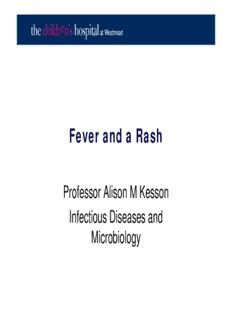
A/Prof Alison Kesson - Fever and a rash in children – current PDF
Preview A/Prof Alison Kesson - Fever and a rash in children – current
Fever and a Rash Professor Alison M Kesson Infectious Diseases and Microbiology Approach to Diagnosis • This is not easy !!! • Rash may or may not be diagnostic • Will need history, physical exam and investigations • HISTORY – Prior infectious diseases – Immunisations – Travel – Prodromal illness – Contacts Approach to Diagnosis • PHYSICAL EXAM – General state – Temperature – Conjuctiva – Ears and throat – Auscultation of chest – Abdomen – liver and spleen – Lymph nodes Types of rashes • Vesicles and Bullae • Purpura and ecchymoses • Macular • Papules • Urticaria • Erthema multifomae • Erythema nodosum Vesicles and Bullae Vescicles • Result from a disturbance of cohesion of epidermal cells or components of a basement membrane zone associated with influx of fluid into or beneath the site of disturbance. • Vesicles < 1cm; bullae > 1cm • Rapidly evolve into erosions, ulcers or crusts. • Most are benign, others are rapidly progressive and life threatening. Vesicular rashes • VZV • HSV • Enterovirus – hand foot and mouth disease • Impetigo • Contact dermatitis • Pemphigus • Pemphigoid • Incontinentia pigmenti • Epidermolysis bullosa • Burns • Drugs • Allergies Vesicular rashes • Solitary – lesions of streptococcal blistering dactylitis • Localised – staphylococcus bullous impetigo • Grouped or clustered – herpes simples virus infection • Arranged linearly – shingles - Varicella zoster virus • Generalised – chickenpox - varicella. Herpes simplex Herpes simplex
Description: